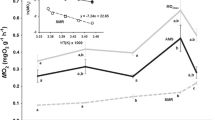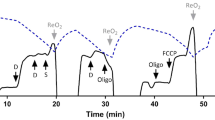Summary
Tench (Tinca tinca) were acclimated to either aerated (P O 2 17.6 KPa) or hypoxic (P O 2 1.5 KPa) water for 6 weeks.
Acclimation to hypoxia resulted in a decrease in mitochondrial volume fraction in both slow (22.9 to 15.0 %) and fast glycolytic (4.5 to 1.8 %) myotomal muscles fibres (P<0.01).
Intermyofibrillar mitochondrial populations (4.4 to 1.2% slow; 0.6 to 0.04% fast fibres) were affected to a greater extent than those in the subsarcolemmal zone (18.5 to 13.8% slow; 3.9 to 1.8% fast fibres). After acclimation to hypoxia, cytochrome-oxidase activities decreased by 31 and 33 % in slow and fast fibres, respectively, but were maintained in the liver.
Fibre size remained unchanged and actively differentiating fibres were observed in muscles from both groups of fish. Hypoxia resulted in a significant increase in myofibrillar volume fraction in both slow (43.1 to 56.1 %) and fast glycolytic fibres (73.1 to 82.7%) (P<0.05).
Glycogen concentrations (mg/100g tissue) for liver (6616) slow muscle (1892) and fast muscle (334) were similar for fish acclimated to aerated or hypoxic water. Acclimation to hypoxia increased carnitine palmitoyl transferase activity (μmoles substrate utilised g·dry wt-1 min-1) in slow (0.42 to 1.1), fast glycolytic muscle (<0.01 to 0.15) and liver (1.1 to 3.7) indicating an enhanced capacity for fatty acid oxidation.
Phosphofructokinase activities of fast glycolytic fibres were similar in fish acclimated to either aerated or hypoxic water, consistent with an unaltered capacity for anaerobic glycogenolysis. Hexokinase activities (μmoles substate utilised, g·dry wt-1 min-1) decreased in fast fibres (1.2 to 0.4) but were maintained in the slow muslce (2.1 to 2.5) and liver (4.5 to 4.8) of hypoxic fish. The activities of phosphofructokinase in slow muscle and phosphofructokinase, pyruvate kinase and lactate dehydrogenase in liver were two times higher in fish acclimated to hypoxia. An enhanced capacity for glycolysis in these tissues may reflect a reduced threshold for anaerobic metabolism during activity and/or an adaptation for acute exposure to anoxia in fish acclimated to hypoxia.
Similar content being viewed by others
Abbreviations
- CO:
-
cytochrome oxidase activity
- CPT:
-
carnitine palmitoyltransferase activity
- HK:
-
hexokinase activity
- LDH:
-
lactate dehydrogenase activity
- PFK:
-
phosphofructokinase activity
- PK:
-
pyruvate kinase activity
- Vv:
-
volume fractions of cell components
- normoxic:
-
fish acclimated to aerated water
- hypoxic:
-
fish acclimated to reduced oxygen tensions
- P O 2 :
-
partial pressure of oxygen tension
References
Akster HA (1981) Ultrastructure of muscle fibres in head and axial muscles of the perch (Perca fluviatilis L.). A quantitative study. Cell Tissue Res 219:111–131
Altringham JD, Johnston IA (1981) Quantitative histochemical studies on the peripheral innervation of cod (Gadus morhua) fast myotomal muscle fibres. J Comp Physiol 143:123–127
Black EC, Robertson AC, Parker PR (1961) Some aspects of carbohydrate metabolism in fish. In: Martin AW (ed) Comparative physiology of carbohydrate metabolism in heterothermic animals. Seattle Univ, Washington, pp 144
Bone Q (1964) Patterns of muscular innervation in the lower chordates. Int Rev Neurobiol 6:99–147
Bone Q (1978) Locomotor muscle. In: Hoar WS, Randal DJ (eds) Fish physiology, Vol III. Academic Press, New York San Francisco London, pp 361–414
Bone Q, Kicenuik J, Jones DR (1978) On the role of the different fibre types in fish myotomes at intermediate swimming speeds. Fish Bull 76:691–699
Burton DT, Heath AG (1980) Ambient oxygen tension (197–04) and transition to anaerobic metabolism in three species of freshwater fish. Can J Fish Aquat Sci 37:1216–1224
Carrol NVR, Longley W, Roe JH (1956) The determination of glycogen in liver and muscle by use of anthrone reagent. J Biol Chem 220:583–593
Crabtree B, Newsholme EA (1972a) The activities of phosphorylase, hexokinase, phosphofructokinase, lactate dehydrogenase, and glycerol 3-phosphate dehydrogenases in muscles from vertebrates and invertebrates. Biochem J 126:49–58
Crabtree B, Newsholme EA (1972b) The activities of upases and carnitine palmitoyltransferase in muscles from vertebrates and invertebrates. Biochem J 130:697–705
Dean JM (1969) The metabolism of tissues of thermally acclimated trout (Salmo gairdneri). Comp Biochem Physiol 29:185–196
Egginton S, Johnston IA (1982) A morphometric analysis of regional differences in myotomal muscle ultrastructure in the juvenile eel (Anguilla anguilla L.). Cell Tissue Res 222:579–596
Guppy M, Hulbert WC, Hochachka PW (1979) Metabolic sources of heat and power in tuna muscles. II. Enzyme and metabolite profiles. J Exp Biol 82:303–320
Guy PS, Snow DB (1977) The effect of training and detraining on muscle composition in the horse. J Physiol 269:33–51
Heath AG, Pritchard AW (1965) Effects of severe hypoxia on carbohydrate energy stores and metabolism in two species of freshwater fish. Physiol Zool 38(4): 325–333
Hidaka T, Toida N (1969) Biophysical and mechanical properties of red and white muscle fibres in fish. J Physiol Lond 201:49–59
Hudson RCL (1969) Polyneuronal innervation of the fast muscles of the marine teleost Cottus scorpius L. J Exp Biol 50:47–67
Hudson RCL (1973) On the function of the white muscles in teleosts at intermediate swimming speeds. J Exp Biol 58:509–522
Johnston IA (1975) Pyruvate kinase from the red skeletal musculature of the carp (Carassius carassius L.). Biochem Biophys Res Commun 63:115–122
Johnston IA (1981a) Quantitative analysis of muscle breakdown during starvation in the marine flatfish Pleuronectes platessa. Cell Tissue Res 214:369–386
Johnston IA (1981b) Structure and function of fish muscle. Symp Zool Soc Lond 48:71–113
Johnston IA (1982a) Quantitative analyses of ultrastructure and vascularization of the slow muscle fibres of the European anchovy Engraulis engrasicolus. Tissue and Cell 14:319–328
Johnston IA (1982b) Capillarisation, oxygen diffusion distances and mitochondrial content of carp muscles following acclimation to summer and winter temperatures. Cell Tissue Res 222:325–337
Johnston IA (1982c) Physiology of muscle in hatchery raised fish. In: Cowey C (ed) Physiology of Salmonid cultivation. Suppl Comp Biochem Physiol (in press)
Johnston IA, Bernard LM (1982) Routine oxygen consumption, and characteristics of the myotomal muscle in tench: Effects of long-term acclimation to hypoxia. Cell Tissue Res 227:161–177
Johnston IA, Maitland B (1980) Temperature acclimation in crucian carp: A morphometric analyses of muscle fibre ultrastructure. J Fish Biol 17:113–125
Johnston IA, Moon TW (1981) Fine structure and metabolism of multiply innervated fast muscle fibres in teleost fish. Cell Tissue Res 219:93–109
Johnston IA, Davison W, Goldspink G (1977) Energy metabolism of carp swimming muscles. J Comp Physiol 114:203–216
Kryvi H (1977) Ultrastructure of the different fibre types in axial muscles of the sharks Etmopterus spinax, and Galeus melastomus. Cell Tissue Res 184:287–300
Kryvi H, Flood PR, Gulaev D (1980) The ultrastructure and vascular supply of the fibre types in the sturgeon — Acipenser stellatus. Cell Tissue Res 212:114–126
McArdle HJ, Johnston IA (1981) Ca2-uptake by tissue sections and biochemical characteristics of sarcoplasmic reticulum isolated from fish fast and slow muscles. Eur J Cell Biol 25:103–107
Mathieu O, Cruz-Orive LM, Hoppeier H, Weibel ER (1981) Measuring error and sampling variation in stereology: comparison of various methods of planar image analysis. J Microscopy 131:75–88
Mole PA, Oscai LB, Hollozy JO (1971) Adaption of muscle to exercise. Increase in levels of palmityl CoA synthetase, carnitine and palmityltransferase and palmityl CoA dehydrogenase and in the capacity to oxidise fatty acids. J Clin Invest 50:2323–2330
Moon TW, Hulbert WC (1980) Regulatory properties of pyruvate kinases isolated from tissues of the American eel, Anguilla rostra Le seur. Comp Biochem Physiol 65B:291–296
Moon TW, Johnston IA (1980) Starvation and the activities of glycolytic and gluconeogenic enzymes in skeletal muscles and liver of the plaice, Pleuronectes platessa. J Comp Physiol 36:31–38
Müller W (1976) Subsarcolemmal mitochondria and Capillarisation of soleus muscle fibres in young rats subjected to an endurance training. Cell Tissue Res 174:367–389
Nag AC (1972) Ultrastructure and adenosine triphosphatase activity of red and white muscle fibres of the caudal region of a fish, Salmo gairdneri. J Cell Biol 55:42–57
Newsholme EA, Start C (1973) Regulation in metabolism. Wiley, New York, pp 349
Newsholme EA, Zammit VA, Crabtree B (1978) The role of glucose and glycogen as fuels for muscle. Biochem Soc Trans 6:512–520
Patterson S, Goldspink G (1972) The fine structure of red and white myotomal muscle fibres of the coalfish (Gadus virens). Z Zellforsch mikrosk Anat 133:463–474
Patterson S, Goldspink G (1973) The effect of starvation on the ultrastructure of the red and white myotomal muscles of the Crucian carp (Carassius carassius). Z Zellforsch mikrosk Anat 146:375–384
Sidell BD (1980) Responses of goldfish (Carassius auratus L.) muscle to acclimation temperature: alterations in biochemistry and proportions of different fibre types. Physiol Zool 53:98–107
Smith MJ, Heath AG (1980) Responses to acute anoxia and prolonged hypoxia by rainbow trout (Salmo gairdneri) and mirror carp (Cyprinnus carpio) red and white muscle: use of conventional and modified metabolic pathways. Comp Biochem Physiol 66B:267–272
Somero GN, Hochachka PW (1968) The effect of temperature on catalytic and regulatory functions of pyruvate kinases of rainbow trout and the Antarctic fish. Trematomus bernacchii. Biochem J 110:395–400
Stanfield PR (1972) Electrical properties of white and red muscles fibres of the elasmobranch fish Scyliorhinus canicula. J Physiol Lond 222:161–186
Stevens ED, Black EC (1966) The effects of intermittent exercise on carbohydrate metabolism in rainbow trout, Salmo gairdneri. J Fish Res Bd Canad Toronto 23:471–495
Totland GK, Kryvi H, Bone Q, Flood PR (1981) Vascularization of the lateral muscle of some elasmobranchiomorph fishes. J Fish Biol 18:223–234
Van den Thillart G (1977) Influence of oxygen availability on the energy metabolism of goldfish, Carassius auratus L. PhD thesis State University of Leiden, The Netherlands
Van den Thillart G, Kesbeke F, Waarde AV (1976) Influence of anoxia on the energy metabolism of goldfish Carassius auratus (L.). Comp Biochem Physiol 554:329–336
Van den Thillart G, Kesbeke F, Waarde AV (1980) Anaerobic energy metabolism of goldfish (Carassius auratus L.). Influence of hypoxia and anoxia on phosphorylated compounds and glycogen. J Comp Physiol 136:45–52
Weibel ER (1980) Stereological methods. Vol1: Practical methods for biological morphometry. Academic Press, London, pp 416
Wood SC, Johansen K (1972) Adaptation to hypoxia by increased HbO2 affinity and decreased red cell ATP concentrations. Nature NB 237:278–279
Wood SC, Johansen K (1973) Blood oxygen transport and acid-base balance in eels during hypoxia. Am J Physiol 225(4):849–851
Zammit VA, Newsholme EA (1979) Activities of enzymes of fat and ketona-body metabolism and effects of starvation on blood concentrations of glucose and fat fuels in teleost and elasmobranch fish. Biochem J 184:313–322
Author information
Authors and Affiliations
Rights and permissions
About this article
Cite this article
Johnston, I.A., Bernard, L.M. Ultrastructure and metabolism of skeletal muscle fibres in the tench: Effects of long-term acclimation to hypoxia. Cell Tissue Res. 227, 179–199 (1982). https://doi.org/10.1007/BF00206340
Accepted:
Issue Date:
DOI: https://doi.org/10.1007/BF00206340




